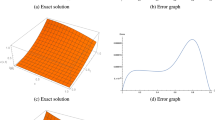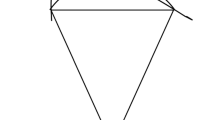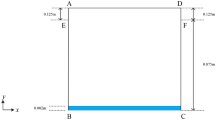Abstract
In this paper, a numerical scheme based on quintic B-spline collocation method using the Strang splitting technique is presented for solving the generalised Rosenau–regularised long wave (RLW) equation given by appropriate initial-boundary values. For this purpose, firstly the problem is split into two subproblems such that each one includes the derivative in the direction of time. Secondly, each subproblem is reduced to a system of ordinary differential equations (ODEs) using collocation finite-element method with quintic B-splines for spatial integration. Then, the resulting ODEs for time integration are solved using the Strang time-splitting technique with the second order via the usual Runge–Kutta (RK-4) algorithm with the fourth order. To measure the accuracy and efficiency of the present scheme, a model problem with an exact solution is taken into consideration and investigated for various values of the parameter p. The error norms \(L_{2}\) and \(L_{\infty }\) together with the invariants of discrete mass Q and discrete energy E have been computed and a comparison is given with other ones found in the literature. The convergence order of the present numerical scheme has also been computed. Furthermore, the stability analysis of the scheme is numerically examined.




Similar content being viewed by others
References
P Rosenau, Phys. Scr. 34, 827 (1986)
P Rosenau, Progr. Theoret. Phys. 79, 1028 (1988)
M A Park, Mat. Aplic. Comp. 9, 145 (1990)
J M Zuo, Y M Zhang, T D Zhang and F Chang, Bound. Value Probl. 2010, 13 (2010)
J M Zuo, Y M Zhang, T D Zhang and F Chang, Bound. Value Probl. 2010, 13 (2010)
X Pan and L Zhang, Appl. Math. Model. 36, 3371 (2012)
X Pan and L Zhang, Math. Prob. in Eng. 2012, 15 (2012)
R C Mittal and R K Jain, Commun. Numer. Anal. 2012, 16 (2012)
X Pan, K Zheng and L Zhang, Appl. Anal. 92, 2578 (2013)
J Hu and Y Wang, Math. Prob. Eng. 2013, 8 (2013)
N Atouani and K Omrani, Comput. Math. Appl. 66, 289 (2013)
B Wongsaijai, K Poochinapan and T Disyadej, Int. J. Appl. Math. 44(4), 5 (2014)
N M Yagmurlu, B Karaagac and S Kutluay, Am. J. Comput. Appl. Math. 7(1), 1 (2017)
H Wang, S Li and J Wang, Comput. Appl. Math. 36, 63 (2017)
W Hundsdorfer, Lecture notes for Ph.D. course (Thomas Stieltjes Institute, Amsterdam, 2000)
B Gustafsson, High order difference methods for time dependent PDE, in: Springer series in computational mathematics (Springer-Verlag, Berlin, New York, Heidelberg, 2007) p. 38
M D Buhlmann, Radial basis functions, in: Cambridge monographs on applied and computational mathematics (Cambridge, 2004)
J Geiser and K Bartecki, AIP Conf. Proc. 470002, 1978 (2018)
J Geiser, Decomposition methods for differential equations: Theory and applications, in: Chapman & Hall/CRC numerical analysis and scientific computing series (Chapman & Hall, New York, 2009)
J Geiser and A Nasari, Math. Comput. Appl. 24, 76 (2019)
J Geiser, Multicomponent and multiscale systems – Theory, methods, and applications in engineering (Springer International Publishing, AG, 2016)
G Strang, SIAM J. Numer. Anal. 5, 506 (1968)
R I McLachlan and G R W Quispel, Acta Numer. 2001, 341 (2001)
S Blanes and F Casas, A concise introduction to geometric numerical integration (CRC Press, 2016)
J Geiser, J. Algorithm Comput. Technol. 9(1), 65 (2013)
G I Marchuk, Appl. Math. 13, 103 (1968)
S Blanes and F Kasas, Appl. Numer. Meth. 54, 23 (2005)
M Seydaoğlu and S Blanes, Appl. Numer. Meth. 84, 22 (2014)
M Seydaoğlu, U Erdogan and T Oziş, J. Comput. Appl. Math. 291, 410 (2016)
S Ganesan and L Tobiska, Appl. Math. Comput. 219, 6182 (2013)
I Carbone and A Volcic, Rend. Istit. Mat. Univ. Trieste XXXIX, 119 (2007)
F Zürnacı and M Seydaoğlu, Numer. Meth. Part. D E 35(1), 1363 (2019)
W Hundsdorfer and J Verwer, Numerical solution of time-dependent advection-diffusion-reaction equations (Springer-Verlag, Berlin, Heidelberg, 2003)
P M Prenter, Splines and variational methods (Wiley, New York, 1975)
H Wang, J Wang and S Li, Bound. Value Probl. 2015, 11 (2015)
S Kutluay, M Karta and N M Yağmurlu, Numer. Meth. Part. D E 35, 2221 (2019)
Abbas I Abdel Karim, Comput. J. 9(3), 308 (1966)
John W Carr, J. Assoc. Comp. Mach. 5(1), 39 (1958)
Acknowledgements
The authors would like to express their sincere thanks to referees and editor for their many valuable suggestions and comments to improve the quality of the paper.
Author information
Authors and Affiliations
Corresponding author
Rights and permissions
About this article
Cite this article
Kutluay, S., Karta, M. & Uçar, Y. Strang time-splitting technique for the generalised Rosenau–RLW equation. Pramana - J Phys 95, 148 (2021). https://doi.org/10.1007/s12043-021-02182-1
Received:
Revised:
Accepted:
Published:
DOI: https://doi.org/10.1007/s12043-021-02182-1




